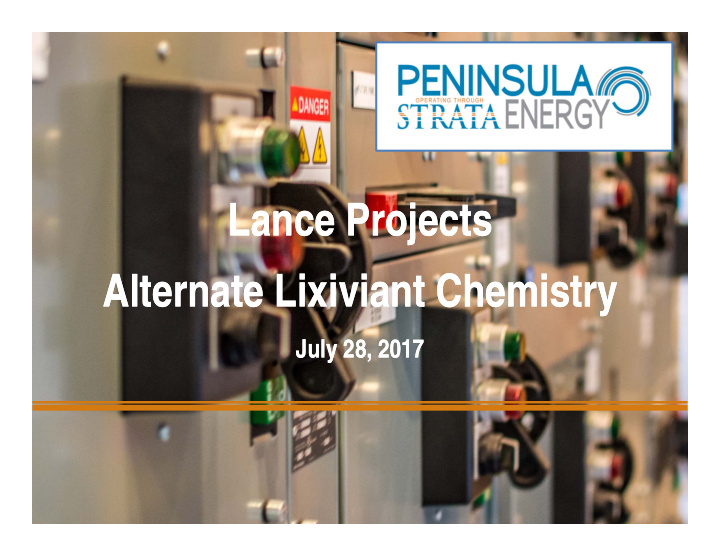



Lance Projects Lance Projects Alternate Lixiviant Chemistry Alternate Lixiviant Chemistry July 28, 2017 July 28, 2017
Agenda • Low pH lixiviant – Discussion of reason for request – Results of lab testing – Recovery and Restoration • Permitting process • Update on Agreement State Timeline and how it affects permitting action • Discuss path forward 2 Community Energy
The Issue • Alkaline leach not effective on Lance Projects mineralization • Current head grade and resource recovery below expectations – to date best recovery at 40% • 54 Mlb Wyoming uranium resource at risk • Testing of low pH lixiviants extremely successful 3 Community Energy
Precedent • Two acid leach pilot tests in Wyoming circa late 1970’s – Nine Mile Lake – Reno Creek • ISR Copper in Arizona – San Manuel – Florence – Globe – Miami Unit • Australia • Kazakhstan – Several attenuation demonstrations 4 Community Energy
Mineral Occurrence • Extensive petrology work has identified difference between uranium mineralization in older, Cretaceous age Lance Deposits and Tertiary age deposits • Uranium mineralization in the Powder River Basin and other Tertiary traditionally occurs interstitially 5 Community Energy
Interstitial Uranium Mineralization 6 Community Energy
Lance Deposits Mineralization • Uranium mineralization predominately Uranophane as opposed to more common uraninite or coffenite • Some traditional interstitial mineralization • High percentage of mineralization occurs occluded within secondary chert • Alkaline lixiviant unable to fully contact occluded uranium 7 Community Energy
Lance Interstitial Uranium Mineralization 8 Community Energy
Lance “Chert Occluded” Mineralization 9 Community Energy
Laboratory Testing of Low pH Lixiviants • Strata has tested several low pH lixiviants with very good initial results • Dilute sulfuric acid leach very effective • Citric acid with oxidizer also effective • 90 – 95% recovery in 20 pore volumes (PV) compared to 40% recovery with alkaline lixiviant • Initial restoration testing very positive 10 Community Energy
Low pH: 95% Recovery in 20 Pore Volumes 11 Community Energy
Alkaline: 40% Recovery in 20 Pore Volumes 12 Community Energy
Other Low pH Lixiviants 13 Community Energy
Restoration Simulation Results 14 Community Energy
Changes to Permit to Mine • Low pH leaching within capacity of current facility • Plant operations minimal impact • Excursion monitoring parameters may change • Restoration standards remain the same – Restoration techniques may change • Ground water restoration impact on bonding 15 Community Energy
Regulatory Context • No prohibition to low pH lixiviants • LQD Regulatory Approach – R & D Testing License – Non Significant Revision – Significant Revision • Materials license – Post Agreement State amendment • WQD Regulatory Implications / Other 16 Community Energy
Path Forward • LQD feedback on concept and regulatory approach • Further laboratory testing by Strata of leaching and restoration • Strata prepares White Paper for LQD – Historical & international experience – Detail effects on Permit to Mine – Summarize safety and environmental implications 17 Community Energy
Recommend
More recommend